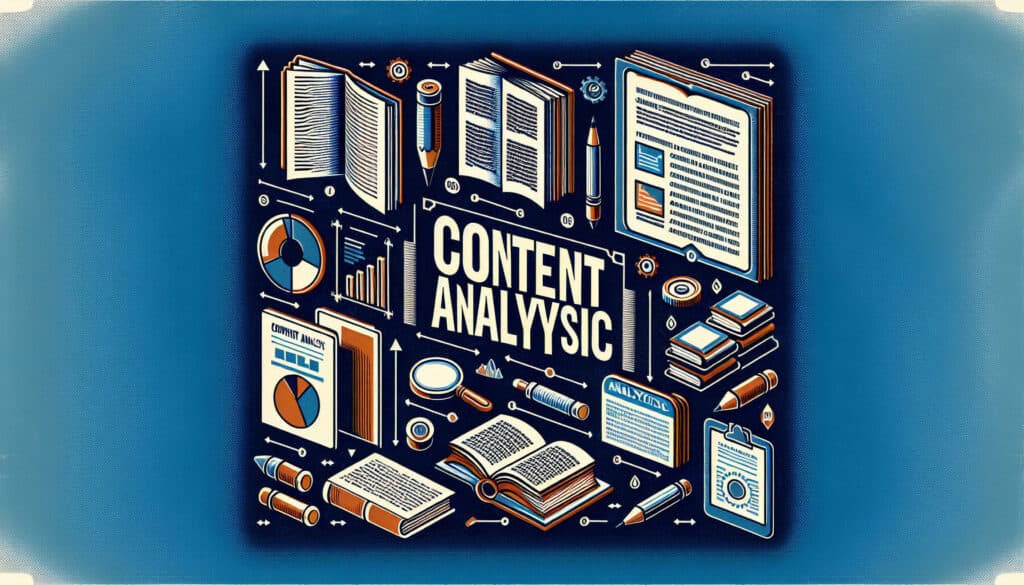Une technique de recherche utilisée pour faire des déductions reproductibles et valides en interprétant et en codant le matériel textuel.
- Méthodologies : Clients et marketing, Idéation, Conception de Produits
Analyse du contenu

Analyse du contenu
- Analyse de la variance (ANOVA), Analyse environnementale comparative, Recherche et développement, Statistical Analysis, Contrôle statistique des processus (CSP)
Objectif :
Comment il est utilisé :
- Les chercheurs classent et analysent systématiquement des textes, des images ou d'autres médias afin d'identifier des modèles, des thèmes et des significations. Il peut s'agir d'une analyse quantitative (compter les mots) ou qualitative (interpréter les thèmes).
Avantages
- Il fournit une méthode systématique et objective d'analyse des données qualitatives, permet de traiter de grands volumes de données textuelles et peut être utilisé pour découvrir des tendances et des modèles dans la communication.
Inconvénients
- Elle peut prendre beaucoup de temps, l'élaboration de schémas de codage peut être subjective et elle peut négliger le contexte ou les nuances de la communication.
Catégories :
- Clients et marketing, Résolution de problèmes
Idéal pour :
- Analyse systématique d'un contenu textuel ou visuel afin d'identifier et de quantifier des modèles et des thèmes.
L'analyse de contenu sert un large éventail d'applications dans divers secteurs, notamment le marketing, les études médiatiques, les sciences sociales et la recherche sur l'expérience utilisateur dans la conception de produits. Dans des secteurs tels que le développement technologique ou les biens de consommation, cette méthodologie peut s'avérer cruciale pendant la phase exploratoire du développement d'un produit, où la collecte des commentaires des utilisateurs à partir d'enquêtes, de médias sociaux, de forums et d'avis de clients fournit des informations précieuses sur les besoins et les préférences des utilisateurs. Ce sont généralement des analystes ou des chercheurs en conception qui lancent ce processus, souvent soutenus par des équipes interfonctionnelles telles que des stratèges en marketing et des scientifiques des données qui contribuent à la collecte et à l'interprétation des données. Par exemple, une entreprise qui lance un nouvel appareil électronique peut analyser les commentaires des clients et les discussions en ligne pour identifier les thèmes récurrents concernant la fonctionnalité, l'expérience utilisateur ou les problèmes courants rencontrés par les utilisateurs. Cette approche peut révéler non seulement les sentiments dominants, mais aussi des domaines spécifiques d'amélioration qui peuvent conduire à des itérations de conception. L'adaptabilité de l'analyse de contenu lui permet d'évoluer, en combinant des éléments quantitatifs - tels que la fréquence de certains mots clés ou phrases - avec des interprétations qualitatives qui permettent de mieux comprendre les sentiments des utilisateurs. En outre, sa capacité à traiter de grands ensembles de données la rend particulièrement utile pour les organisations qui cherchent à suivre les changements dans le comportement des consommateurs ou les tendances au fil du temps, ce qui permet d'éclairer les décisions stratégiques et de stimuler l'innovation tout au long de la chaîne de valeur de l'entreprise. cycle de vie du produit.
Principales étapes de cette méthodologie
- Définir les questions de recherche ou les objectifs guidant l'analyse.
- Sélectionnez le type de contenu à analyser, tel que du texte, des images ou des médias audiovisuels.
- Élaborer un système de codage basé sur des catégories prédéfinies ou un codage ouvert.
- Coder le contenu de manière systématique, en appliquant le schéma de codage à chaque donnée.
- Utiliser des outils logiciels, le cas échéant, pour la gestion des données et l'analyse du contenu codé.
- Analyser les données codées pour identifier les tendances, les modèles et les thèmes.
- Interpréter les résultats sur la base des thèmes et des modèles identifiés dans le contexte des objectifs de la recherche.
Conseils de pro
- Utiliser des outils logiciels pour le codage et l'analyse automatisés afin de traiter efficacement de grands ensembles de données, en minimisant les erreurs humaines et les biais.
- Incorporez des méthodes mixtes en intégrant des mesures quantitatives à des interprétations qualitatives afin d'enrichir vos résultats et votre validation.
- Affinez continuellement votre schéma de codage par une analyse itérative, permettant l'émergence de nouveaux thèmes au fur et à mesure de l'évolution de votre compréhension des données.
Lire et comparer plusieurs méthodologies, nous recommandons le
> Référentiel méthodologique étendu <
ainsi que plus de 400 autres méthodologies.
Vos commentaires sur cette méthodologie ou des informations supplémentaires sont les bienvenus sur le site web de la Commission européenne. section des commentaires ci-dessous ↓ , ainsi que toute idée ou lien en rapport avec l'ingénierie.
Contexte historique
1828
1850
1854
1854
1911
1928
1950
1827
1848
1850
1854
1895
1914
1943
1970
(si la date est inconnue ou n'est pas pertinente, par exemple "mécanique des fluides", une estimation arrondie de son émergence notable est fournie)















Articles Similaires
Gestion des opérations de fabrication (MOM)
Système d'exécution de la fabrication (MES)
Plan de contrôle de la fabrication
Tests manuels
Tableaux d'évaluation des manutentions manuelles (MAC)
ManTRA (outil d'évaluation des risques liés aux tâches manuelles)